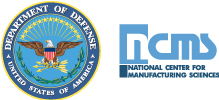057 – “H-53E Main Rotor Blade Repair Using Additive Manufacturing”
Author: Douglas Greenwood
Company: Fleet Readiness Center – East, In-Service Support Center (ISSC), US Navy Air Systems Command (NAVAIR
Phone: (252) 464-6479
Email: douglas.d.greenwood@navy.mil
Fleet Readiness Center – East’s mission is to provide maintenance, repair and overhaul (MRO) services to the USN & USMC fleet of vertical lift aircraft, among them being the CH-53E and MH-53E heavy lift helicopters. Both aircraft use the same Main Rotor Blades (MRB) which are inspected and repaired by FRC-E. Part of this work includes inspection of a collection of polymer parts, known as Blade Inspection Method (BIM) Vents, for cracks or other damage. The BIM Vents are a crucial part of the In-flight Blade Inspection (IBIS) system that monitors nitrogen gas pressure inside the MRB spar (titanium core of the blade) during flight. If a spar crack develops, gas pressure drops and a warning notification is sent to the flight crew. The BIM Vents provide multiple pathways for the nitrogen gas to escape to the atmosphere. Loss of spar pressure can affect the aircraft mission, making the BIM Vents a Critical Application Item (CAI) component.
BIM Vent damage and cracks are normally found beneath layers of adhesive and foam at the root of the blade. Such damage can be repaired but require replacement parts from the OEM. It was determined that no replacement BIM Vent stock was in the supply system which meant that the only alternative repair was to completely strip and rebuild (re-pocket) the MRB at the OEM. Re-pocketing a single MRB costs $210K with a turn-around time (TAT) of 160 days. The problem was further compounded by the fact that NAVSUP had ~400 F-condition MRB’s awaiting inspection and repair. Clearly fleet readiness was negatively impacted by the lack of available BIM Vent repair options.
A cross-functional team was tasked with developing an alternative repair process. The team first determined that the BIM Vent material specified by the OEM was chemically similar to a polymer material used in FRC-East’s Additive Manufacturing (AM) printers. The BIM Vent was modeled in CAD and the design optimized for our printers. Numerous sample parts were printed and subjected to extensive laboratory testing. Laboratory testing concluded that AM BIM Vent parts would perform well during the repair. A repair process was developed and tested multiple times on scrap MRB assets. After the repair process was finalized and documented, it was approved by ISSC engineering. The BIM Vent repair process is now in use at FRC-E.
The use of Polymer AM to print the BIM Vent repair parts is unique and beneficial in many ways. An MRB BIM Vent repair at FRC-E costs $15K with a TAT of 14-21 days, which compares very favorably against re-pocketing an MRB at the OEM. We believe this is the first time a polymer AM part is being used as a CAI component. The repair is viable for both USMC & USN aircraft and we believe FRC-East’s repair capability is unique within the DOD. FRC-E is now able to begin inducting F-condition MRB assets from NAVSUP for inspection and repair. This has the dual benefit of stabilizing work flow through the blade shop and improving fleet readiness.

